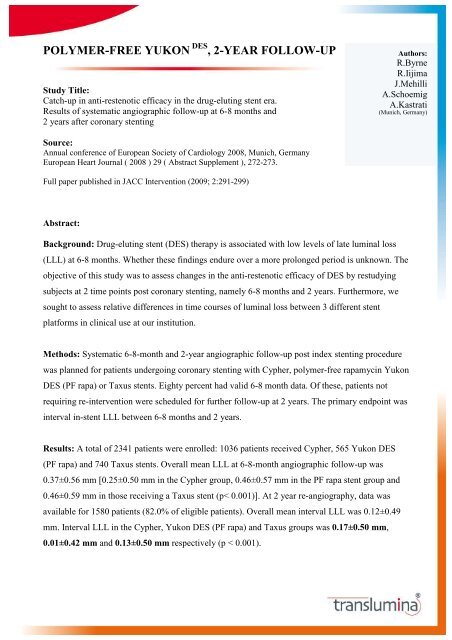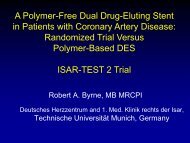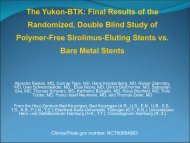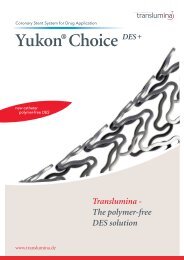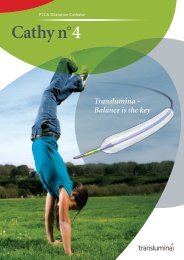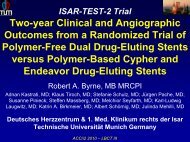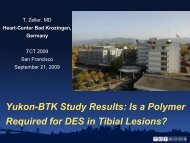PDF download - Translumina
PDF download - Translumina
PDF download - Translumina
Create successful ePaper yourself
Turn your PDF publications into a flip-book with our unique Google optimized e-Paper software.
POLYMER-FREE YUKON DES , 2-YEAR FOLLOW-UP<br />
Study Title:<br />
Catch-up in anti-restenotic efficacy in the drug-eluting stent era.<br />
Results of systematic angiographic follow-up at 6-8 months and<br />
2 years after coronary stenting<br />
Authors:<br />
R.Byrne<br />
R.Iijima<br />
J.Mehilli<br />
A.Schoemig<br />
A.Kastrati<br />
(Munich, Germany)<br />
Source:<br />
Annual conference of European Society of Cardiology 2008, Munich, Germany<br />
European Heart Journal ( 2008 ) 29 ( Abstract Supplement ), 272-273.<br />
Full paper published in JACC Intervention (2009; 2:291-299)<br />
Abstract:<br />
Background: Drug-eluting stent (DES) therapy is associated with low levels of late luminal loss<br />
(LLL) at 6-8 months. Whether these findings endure over a more prolonged period is unknown. The<br />
objective of this study was to assess changes in the anti-restenotic efficacy of DES by restudying<br />
subjects at 2 time points post coronary stenting, namely 6-8 months and 2 years. Furthermore, we<br />
sought to assess relative differences in time courses of luminal loss between 3 different stent<br />
platforms in clinical use at our institution.<br />
Methods: Systematic 6-8-month and 2-year angiographic follow-up post index stenting procedure<br />
was planned for patients undergoing coronary stenting with Cypher, polymer-free rapamycin Yukon<br />
DES (PF rapa) or Taxus stents. Eighty percent had valid 6-8 month data. Of these, patients not<br />
requiring re-intervention were scheduled for further follow-up at 2 years. The primary endpoint was<br />
interval in-stent LLL between 6-8 months and 2 years.<br />
Results: A total of 2341 patients were enrolled: 1036 patients received Cypher, 565 Yukon DES<br />
(PF rapa) and 740 Taxus stents. Overall mean LLL at 6-8-month angiographic follow-up was<br />
0.37±0.56 mm [0.25±0.50 mm in the Cypher group, 0.46±0.57 mm in the PF rapa stent group and<br />
0.46±0.59 mm in those receiving a Taxus stent (p< 0.001)]. At 2 year re-angiography, data was<br />
available for 1580 patients (82.0% of eligible patients). Overall mean interval LLL was 0.12±0.49<br />
mm. Interval LLL in the Cypher, Yukon DES (PF rapa) and Taxus groups was 0.17±0.50 mm,<br />
0.01±0.42 mm and 0.13±0.50 mm respectively (p < 0.001).
Conclusion: Ongoing erosion of luminal calibre beyond 6-8-months post index procedure may be<br />
observed following DES therapy. There appears to exist a device-specificity in this late reduction in<br />
anti-restenotic efficacy in favour of a platform devoid of permanent polymer.<br />
Late luminal loss of the polymer-based Cypher and Taxus stents in comparison with the<br />
polymer-free <strong>Translumina</strong> Yukon DES stent, 2%Rapamycin-coating (PF-Rapamycin).


